
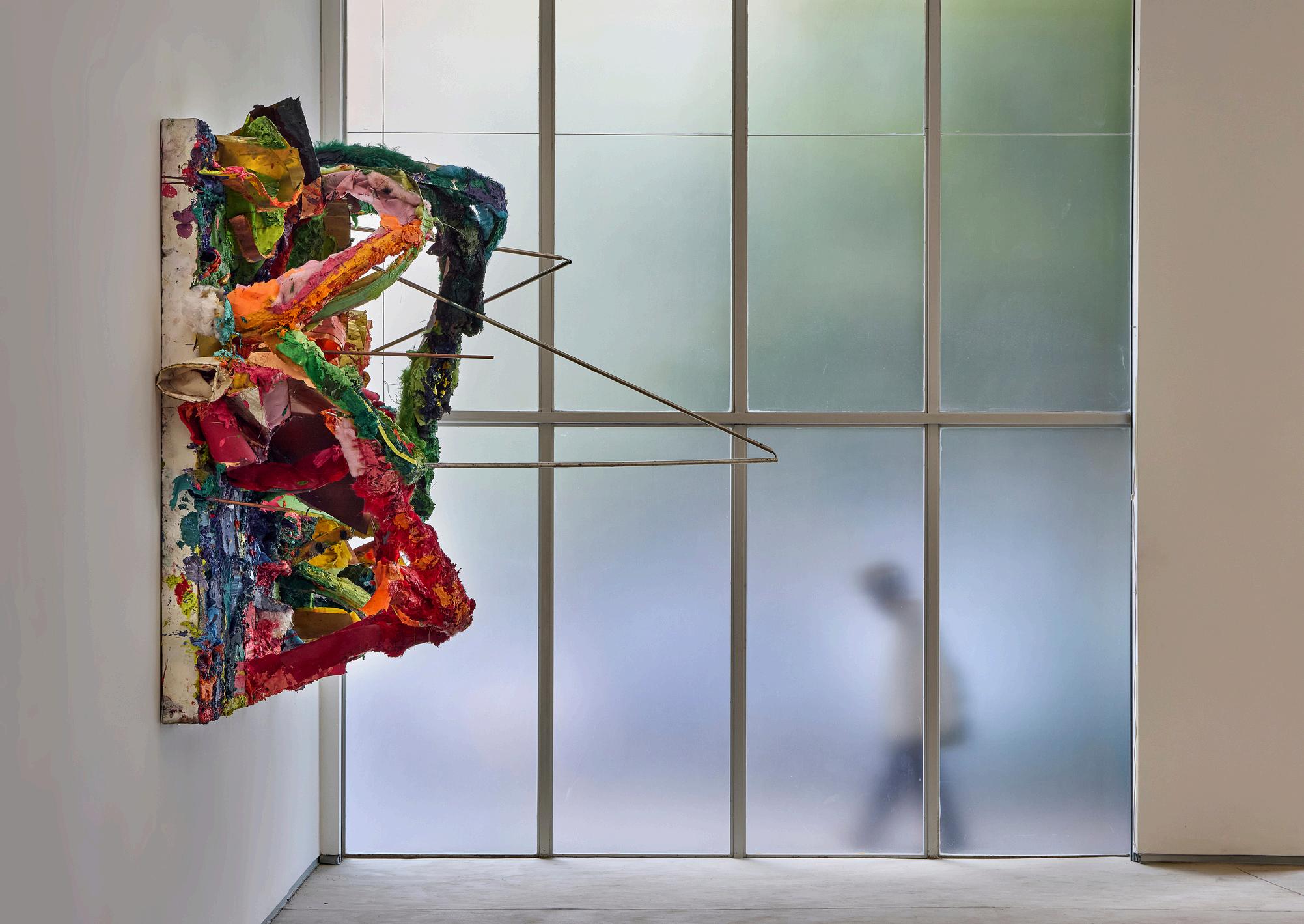



Em 1989, no último andar do pavilhão da Bienal de São Paulo, sem climatização e abafado por conta de um forte sol do verão, Nuno Ramos viu algumas de suas pinturas derreterem. Tratava-se de um conjunto de obras feitas a partir de uma mistura pouco convencional, pela qual o artista logo tornou-se conhecido: uma miscelânia alucinada de tinta à óleo, parafina, vaselina, óleo de linhaça, arame, pedaços de tecido, metais amassados, borrachas, algodão e outros componentes difíceis de identificar.
Desde então, com certas variações, o artista passou a “refazer” periodicamente esses “quadros perdidos”, de algum modo retornando - eis uma hipótese a ser pensada - não só às obras que apresentou na Bienal, quanto à própria cena de sua desintegração; seu “pântano de origem”. É como se tal falha logística, espécie de trauma na linguagem, acentuada ainda por uma hostilidade climática, tivesse aberto não só uma perspectiva de leitura dessas obras, potencializando seu procedimento, mas também instaurado uma nova forma de fazer. Afinal, desde então, sua produção esteve interessada em desafiar a capacidade de convivência e resistência dos materiais mais diversos, tornando a superfície da pintura uma espécie de carne viva, destinada a sustentar um malestar que suspende pretensas conciliações. Derreter, portanto, era uma maneira de realizar uma fantasia que já estava contida na obra: a de moldar um mundo ao seu modo.
In 1989, on the top floor of the São Paulo Biennial pavilion, which had no air conditioning and was stifling due to unseasonably hot sun, Nuno Ramos saw some of his paintings melt. The works in question were made from an unconventional blend of ingredients for which he soon became well-known: a haphazard assortment of oil paint, paraffin, petroleum jelly, linseed oil, wire, scraps of fabric, crushed metal, rubber, cotton, and other less easily identifiable components.
Since then, Ramos has periodically “remade” (with some variations) these “lost paintings,” somehow returning – here’s a hypothesis worth considering – not only to the works he presented at the Biennial, but also to the scene of their disintegration: their “original swamp.” It’s as if that logistical glitch, like a kind of trauma in language that the hostile climatic conditions brought into evidence, had not only opened up a new interpretative perspective on these works, amplifying their procedure, but had also established a new modus operandi. After all, since then, Ramos has focused on challenging the capacity for coexistence and resistance of all manner of materials, turning the surfaces of his paintings into a kind of living flesh doomed to sustain a malaise that holds supposed conciliations in suspension. Melting was therefore a way of realizing a fantasy that was already contained in the work: that of shaping a world in his own way.
Ainda nos anos 1990, ele acrescentaria novos materiais nessa superfície pegajosa: espelho, vidro, folhas metálicas, canos de aço e chapas de latão que fariam a pintura se projetar para fora ainda mais acintosamente. Os quadros crescem não para os lados ou para cima, mas para a frente, na direção de quem olha, em tom não menos ameaçador. Seguir avolumando tais obras era assumir, com total desembaraço, sua vocação monstruosa.
Como afirmou numa conversa este ano em seu ateliê, em tom de blague, Nuno Ramos se sente alimentando um monstro durante a produção dessas pinturas. E ao definir “o lentíssimo Frankenstein” em um de seus ensaios, argumenta que sua forma consistia em “juntar pedaços mortos num todo vivo”. Ou seja, como na sua própria pintura – criatura pesada e histriônica. De predisposição magnética e intensidade condensada, a obra nos leva a imaginar que seria capaz de atrair ainda uma infinidade de outros destroços, restos de um mundo em decomposição, incapaz de distinguir espaço e forma ou constituir imagem.
Se ao longo dos anos o artista desafiou a capacidade que teriam esses materiais empilhados (esses “quadros”) de se sustentarem na estrutura superficial e retangular da tela é porque seguiu atraído por certa dimensão catastrófica da experiência artística, bem como por regiões limítrofes de desintegração formal. “Esse momento do ‘quase’ é o que eu gosto. Se eu pudesse fixar um momento, eu fixava isso.
Essa hora de transição. Eu não gosto quando cai, mas eu realmente não gosto quando fica”, declarou em outra entrevista.
In the 1990s, Ramos added new materials to these viscid surfaces: mirror, glass, sheet metal, steel pipes, and brass plates, which projected his paintings outwards even more brazenly. The paintings grew forwards, not sideways or upwards, towards whomever was viewing them, in a no less threatening way. To blithely carry on adding more and more volume to these works was nothing short of admitting their monstrous vocation.
As Nuno Ramos joked in a conversation in his studio this year, whenever he works on these paintings, he feels like he’s feeding a monster. And when he defines his “slow-motion Frankenstein” in one of his essays, he argues that its form consists of “joining dead parts into a living whole.” Which is much like his paintings: heavy, histrionic creatures. With its magnetic predisposition and condensed intensity, his work prompts us to imagine how it might attract an infinity of other debris, remains of a decomposing world, incapable of distinguishing space and form or constituting an image. If over the years Ramos has consistently challenged the capacity of these heaped materials (these “paintings”) to hold themselves up on the rectangular surface of the canvas, it’s because he has never ceased to be attracted to what one might call the catastrophic dimension of the art experience and the very brink of formal disintegration. As he said in another interview, “this ‘almost’ point is what I like. If I could capture any moment, that’s the one I would capture. That time of transition. I don’t like it when they fall, but I really don’t like it when they stay.”

Estas novas obras, no entanto, além de não mais derreterem e de apresentarem uma paleta mais histérica, já distante do baixo contraste tonal dos anos 1980, passaram a receber títulos que em geral fazem referências a outros discursos e objetos culturais, como é do gosto do artista: “Uns”, “O sol não adivinha”, “La noche oscura”, “Los pasos perdidos”, entre outros. Como ocorre com as formas, as cores e os materiais no território do quadro, os títulos não têm necessariamente relação entre si, e são como fragmentos que se justapõem e se aglutinam na superfície da tela; um modo de expandir não apenas o “vocabulário” das obras como, sobretudo, o seu próprio volume.
“Los pasos perdidos”, em especial, se apresenta como chave de leitura para a mostra, já que também dá nome à exposição. Título de um romance do escritor cubano Alejo Carpentier, o livro narra uma viagem de volta ao passado. Trata-se do relato de um músico que decide viajar às suas origens, na selva venezuelana, em busca de instrumentos musicais primitivos. Ao adotar o título para a exposição, Nuno Ramos parece apontar para algo (“los pasos”) que deve ser rememorado, apesar de seu extravio.
Como se sabe, a obra do artista lança constantemente mão não apenas de uma colagem de citações, como convoca outras vozes na formação de um coro de dissonâncias. Na mostra, outra menção expressiva é a Kasimir Malevich, aquele para quem, na Rússia do início do século XX, as formas tradicionais deveriam ser destruídas em busca de um grau zero capaz de revelar o verdadeiro material da arte. “Transformei a mim mesmo no zero
Yet the new works here no longer melt, and their palette is far more hysterical than the muted tonal contrasts of the 1980s. The titles he gives them also tend to refer to other cultural objects and discourses, as is his wont: Uns [a few], O sol não adivinha [the sun can’t guess], La noche oscura [the dark night], Los pasos perdidos [the lost steps], among others. As with the paintings’ shapes, colors, and materials, their titles are not necessarily related to one another; they are more like fragments juxtaposed and coalesced on the surface of the canvas – a way of expanding not only the “vocabulary” of the works but, above all, their own volume.
Los pasos perdidos, in particular, gives us a clue as to how to make sense of the exhibition, since it’s also the name of the exhibition. This title is borrowed from a novel by the Cuban writer Alejo Carpentier, which tells the story of a journey into the past: the story of a musician who decides to travel back to his origins in the Venezuelan jungle in search of primitive musical instruments. By borrowing the title for his exhibition, Nuno Ramos seems to point to something (the steps) that should be remembered, despite having been lost. Typically, Ramos not only makes use of collages of quotes, but also draws on other voices to form a chorus of dissonance. Another significant reference here is Kazimir Malevich, who, in early twentieth-century Russia, declared that traditional forms should be destroyed in the quest for a “zero of form” that might reveal the true material of art.
“I turned myself into the zero of form and emerged as the zero of one,” the suprematist would say, taking himself back to the blank sheet, which is the opposite of Ramos’s procedure.

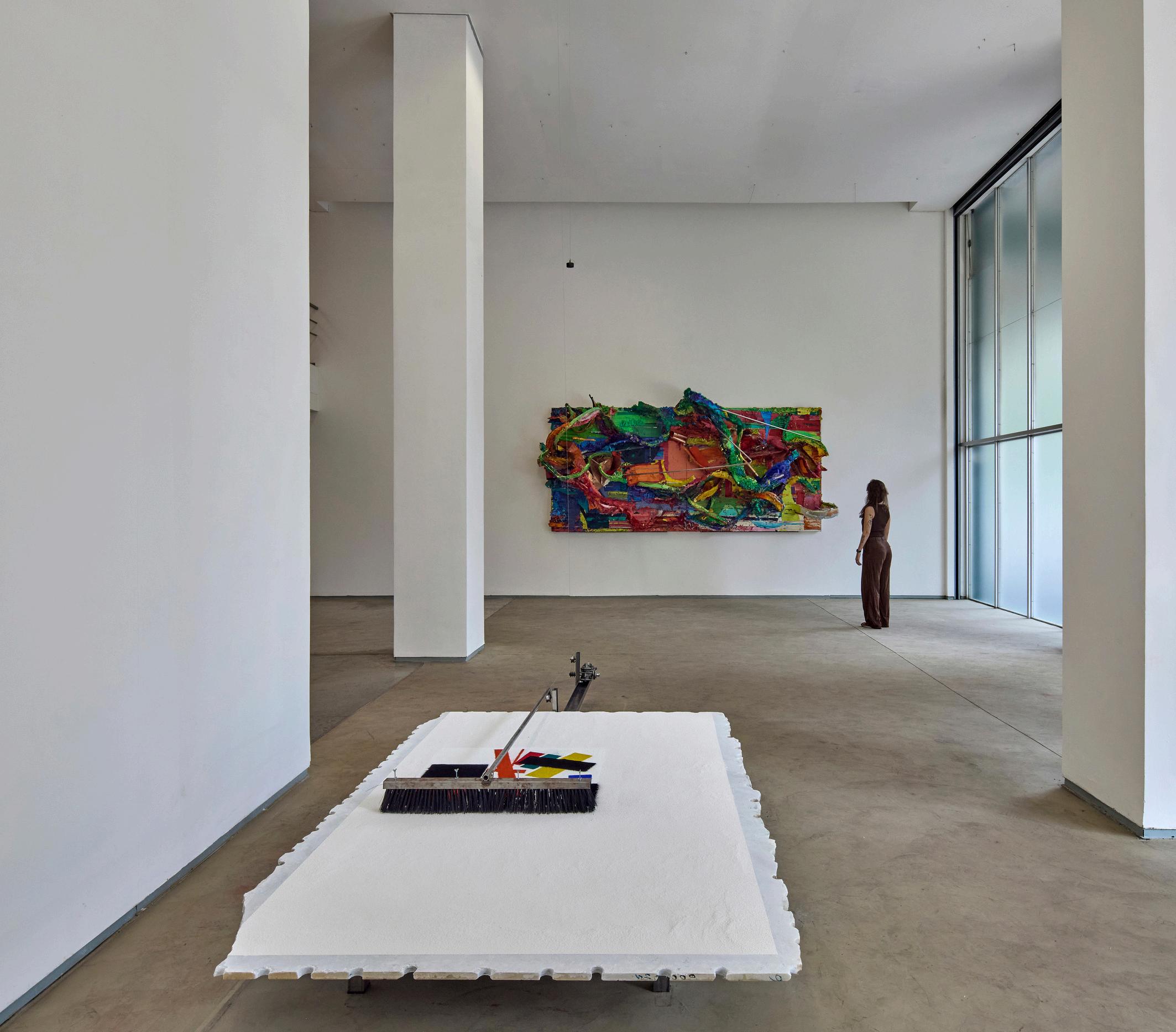
no zero das formas e surgi como o zero de um”, diria o suprematista, apostando numa tábula rasa contrária aos procedimentos de Nuno. Atravessar a catástrofe do progresso e mobilizar a destruição como força propositiva; reduzir, começar de novo, voltar à origem da linguagem, tocá-la pela primeira vez.
Em um trabalho inédito, três obras de Malevich foram reproduzidas em tamanho original em pó de mármore sobre pedra, cuja imagem será progressivamente apagada por uma maquininha elegante que avança três centímetros por dia. Os escolhidos de Nuno não são os hits de quadrados pretos e brancos, mas versões mais heterogêneas, compostas por quadriláteros e linhas coloridas que dançam pelo espaço branco (algo neles faz lembrar algumas das melhores obras do neoconcretismo brasileiro, aqui decantado à uma de suas origens). Além disso, são exemplos que reforçam que Malevich não tem o mesmo rigor de Mondrian e que, apesar de primárias, suas formas são imperfeitas, por vezes mais dinâmicas e, talvez por isso, mais vivas. Um pouco falhas, elas carecem de uma virtualidade ideal, rendendo um ruído entre texto vanguardista e visualidade.
Em alguma medida, Nuno refaz o gesto de desfiguração progressiva que fundamenta o próprio Suprematismo. Ironicamente, a destruição aqui tem ares contemplativos (a lentidão, as mandalas de areia), o que rememora a mística malevichiana; sua ambição em atingir o “nada revelado”, superando a representação para pôr a nu o que transcende. Porém, finalizado o ritual, o que sobra não é o almejado grau zero, mas um punhado de cinzas, um rastro
Traversing the catastrophe of progress and galvanizing destruction as a propositional force; reducing, starting over, going back to the origin of language; touching it for the first time.
In a new work, Ramos reproduces three of Malevich’s pieces in their original size in marble powder on stone, then gradually erodes them by means of an elegant machine that advances three centimeters a day. His choices are not the hits of black and white squares, but more heterogeneous versions composed of colored lines and quadrilaterals that dance across the white space. (Something about them brings to mind some of the best works of Brazilian neoconcretism, decanted to one of their origins). Furthermore, these are examples that demonstrate how Malevich does not match Mondrian for his rigor and how his forms, while primary, are nonetheless imperfect, sometimes more dynamic and, perhaps for this reason, more alive. Slightly flawed, they fail to display an ideal level of virtuality, introducing interference between avant-garde text and visuality.
To some extent, Ramos recreates the gesture of progressive disfiguration that underpins suprematism itself. Ironically, the destruction at play here has a somewhat contemplative air (the slow pace, the sand mandalas), which recalls Malevich’s mysticism: his ambition to achieve “revealed nothingness,” to turn his back on representation and lay bare the transcendental. However, once the ritual is complete, what remains is not the desired zero of form, but a handful of ashes, a haphazard trail, the trace of a movement that deforms the composition and interweaves its colors, ultimately producing the very image of its erasure.

desordenado, o registro de um movimento que deforma a composição e entremeia suas cores produzindo, em última instância, a própria imagem de seu apagamento.
O dispositivo que as destrói é ao seu modo uma máquina de produção de desejo, ecoando algo da perversidade industrial de Duchamp e Man Ray. Delicada, apesar de violenta, sua teimosia em desfazer as imagens é explícita e pode soar controversa, mas isso não é tudo. Se ela produz desejo, o resultado do seu trabalho não se apresenta sob a forma de um produto, e sim de um borrão, na melhor das hipóteses um desenho informe, como se voltasse a algo das pinturas outra vez. Na versão do artista, o que o grau zero encontra é não a possibilidade de uma nova ordem, mas uma versão do caos, em miniatura.
A obra se constitui como um agenciamento que se divide e se conecta em três partes: é um desenho em areia, na reprodução de Malevich, múltiplo provisório que deve ser visto no início da mostra e que logo será perdido; é também a própria máquina desejante que funciona ao longo de todo o período expositivo; e finalmente o borrão na versão final. Ao solicitar do espectador que seja vista assim, em sua duração, como se fosse um pequeno teatro do absurdo, ou um organismo vivo, a obra questiona seu próprio estatuto de imagem em nome de uma existência mais móvel.
Por fim, as pinturas sobre papel (ou desenhos, como o artista intitula) parecem prestar tributo a Mark Rothko, para quem a cor é coisa desmaterializada, jamais refém dos contornos da forma - fruto da melhor fusão entre Turner e Matisse. Mas se o mestre judeu aspirava à
The device that destroys the works is, in its own way, a desiremaking machine, echoing something of the industrial perversity of Duchamp and Man Ray. Delicate yet violent, its persistence in unmaking the images is explicit and may even appear controversial, but that is not where it stops. If it makes desire, its work doesn’t result in the form of a product, but a blur, a shapeless drawing at best, as if it were referring back again to something from the paintings. In Ramos’s version, what the zero of form encounters is not so much the potential for a new order as a miniature version of chaos.
Each of these works is constituted as an arbitration among three divided and interconnected parts: it is a sand drawing, in the reproduction of Malevich: a provisional multiple that must be seen at the beginning of the show and is soon to be lost; it is also the desire-making machine itself, which keeps running throughout the whole exhibition period; and finally, it is the blur in the final version. By asking the viewer to see it like this, throughout its duration, as if it were a mini theater of the absurd or a living organism, the works question their own status as an image in the name of a more malleable existence.
Finally, the paintings on paper (or “drawings,” as the artist calls them) seem to pay tribute to Mark Rothko, for whom color is a dematerialized thing that is never constrained by the contours of the form: the outcome of an ultimate fusion of Turner and Matisse. But if the Jewish master aspired to order, stability, and balanced asymmetry in search of a metaphysical ideal to be achieved through abstract form (and here we see the lesson learnt from Mondrian), in Ramos what is left is mistrust, tension, disintegration, and materialism.
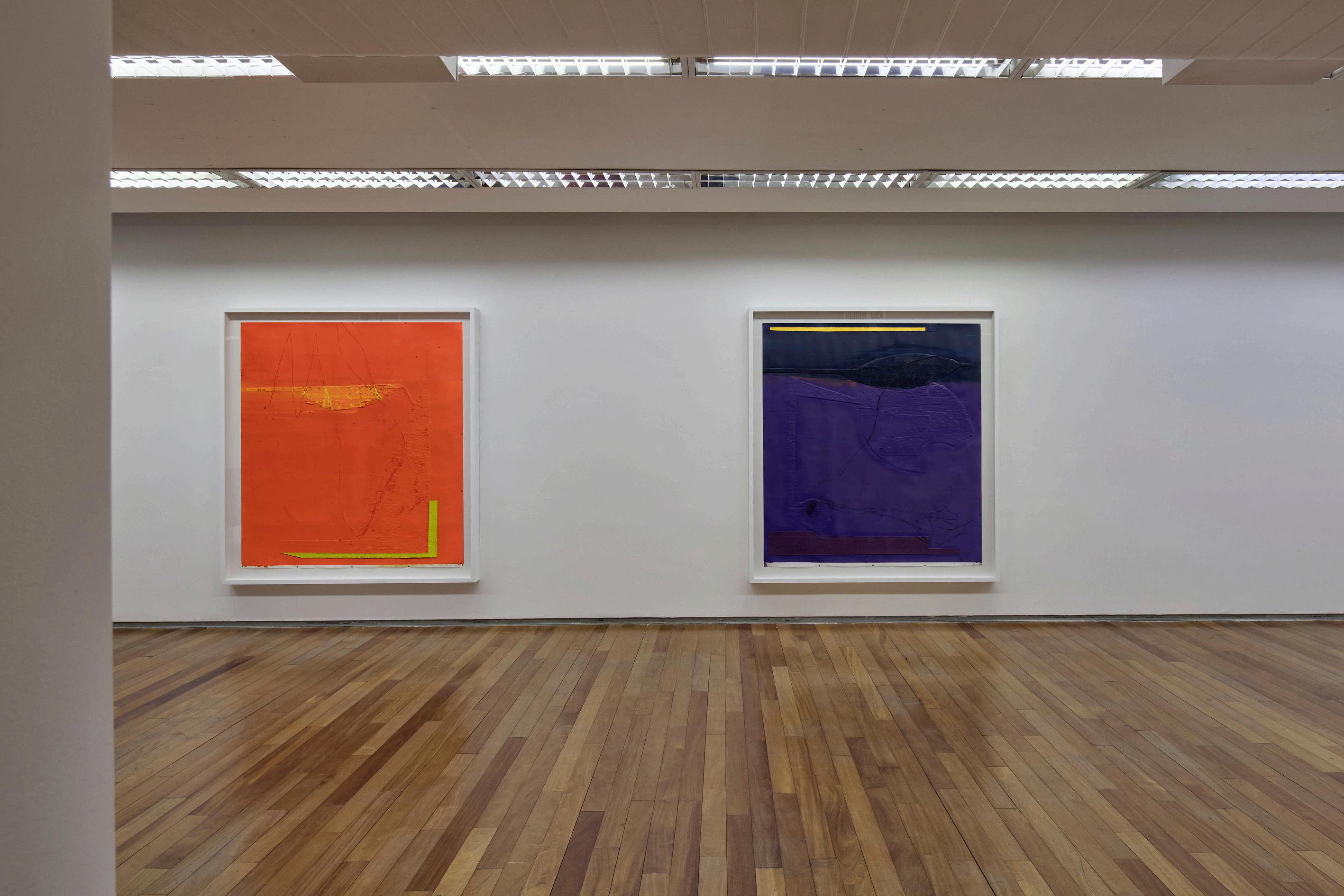
ordem, à estabilidade e à assimetria equilibrada, em busca de um ideal metafísico conquistado por meio da forma abstrata (eis a lição de Mondrian), em Nuno resta desconfiança, tensão, desintegração e materialismo. Se em Rothko a cor vaporosa é resultado de uma espécie de técnica de aquarela traduzida para o óleo, nos desenhos de Nuno o papel pesa com camadas de tinta espessa. Rothko organiza seu fluxo compositivo a partir de uma sucessão de faixas horizontais dispostas verticalmente, enquanto Nuno joga com a sobreposição, estabelecendo uma relação crítica entre figura e fundo.
Nessas obras, o artista produz relevos geométricos encorpados de tinta que, cobertos por camadas subsequentes, fazem da forma uma sombra guardada e sufocada sob a superfície, por vezes buscando emergir, em conflito. Tal procedimento é ainda conjugado com linhas orgânicas adquiridas através de monotipia, produzindo sulcos finos que se espalham e “machucam” as grandes massas de óleo. Mais velozes e feitos “às cegas”, eles se contrapõem a um efeito mais contemplativo de fundo. Aqui, a fantasia incorpórea do sublime está abafada pela realidade material da pintura, e existe senão como memória ou eco, já desencontrada de sua ambição espiritual.
“Los pasos perdidos” é uma exposição cuja força, por meio de seus três conjuntos de obras, parece residir nesse movimento duplo de, por um lado, voltar a observar um objeto amado e, por outro, refazê-lo à sua maneira, reconstruir algo de sua primeira energia. Nesse movimento, muito fica pelo caminho - perde-se algo do
materialism. If Rothko’s vaporous color emerges from a kind of watercolor technique translated into oil, the paper in Ramos’s drawings is weighed down by layer upon layer of thick paint. Rothko organizes his compositional flow on a succession of horizontal bands arranged vertically, while Ramos experiments with overlaps, setting up a critical relationship between figure and ground.
In these works, Ramos makes geometric reliefs out of paint, whose form, covered over by subsequent layers, turns into a shadow held suffocated beneath the surface, sometimes trying to get out, in disarray. This procedure is also combined with organic lines produced by monotyping, resulting in fine grooves that spread out and “hurt” the large masses of oil paint. Produced “blindly” at a faster pace, they offset the more contemplative effect of the ground. Here, the disembodied fantasy of the sublime is quashed by the material reality of the painting and exists only as a memory or an echo, already disconnected from its spiritual aspiration.
Los pasos perdidos is an exhibition whose strength, through its three sets of works, seems to reside in this dual movement of both casting a new gaze on a beloved object while also remaking it at will, reconstituting something of its original energy. In this movement, much is left by the wayside –something of the referent is lost; the lost object will never be the same again; the attempt to reproduce it is flawed – but a renovating intensity emerges. In other words, the work sheds its skin and undergoes its own metamorphosis.
referente, o objeto perdido nunca mais será o mesmo, erra-se na tentativa de reprodução - mas uma intensidade renovadora emerge. Ou seja, a obra troca de pele, e faz sua própria metamorfose.
Essa é, afinal, para Nuno Ramos, conforme diz na entrevista já mencionada, “a coisa toda de fazer arte”: “tentar voltar ao primeiro livro, voltar à primeira versão do livro que eu li, onde as coisas estavam ali mesmo, me esperando”. Na ocasião, o artista se referia a uma releitura decepcionante que fez do livro mais amado da sua infância, Robinson Crusoé, refletindo a partir daí sobre qual seria “o sentido de alguém ficar tentando refazer o que se perdeu”. Sua conclusão é reveladora justamente ao esclarecer uma espécie de motor de sua obra. “Houve para mim uma separação de algo que amei perdidamente”, disse o artista sobre o livro de Daniel Defoe, mas poderia estar falando das suas pinturas derretidas, seus monstros, de Rothko e Malevich, los pasos perdidos.
As far as Nuno Ramos is concerned, this is ultimately “what making art is all about”: “trying to get back to the first book, to get back to the first version of the book I read, where things were right there waiting for me.” When he spoke these words, Ramos was referring to how disappointed he felt when he reread his most beloved childhood book, Robinson Crusoe, and was reflecting on what sense it would make to “for someone to keep trying to remake what’s been lost.” The conclusion he reaches is revealing precisely because it clarifies what might be a driving force of his work. Speaking about his experience of rereading Daniel Defoe’s classic, he said, “for me, it separated me from something I was madly in love with.” But he might just as well have been talking about his own melted paintings, his monsters, Rothko, Malevich, los pasos perdidos.





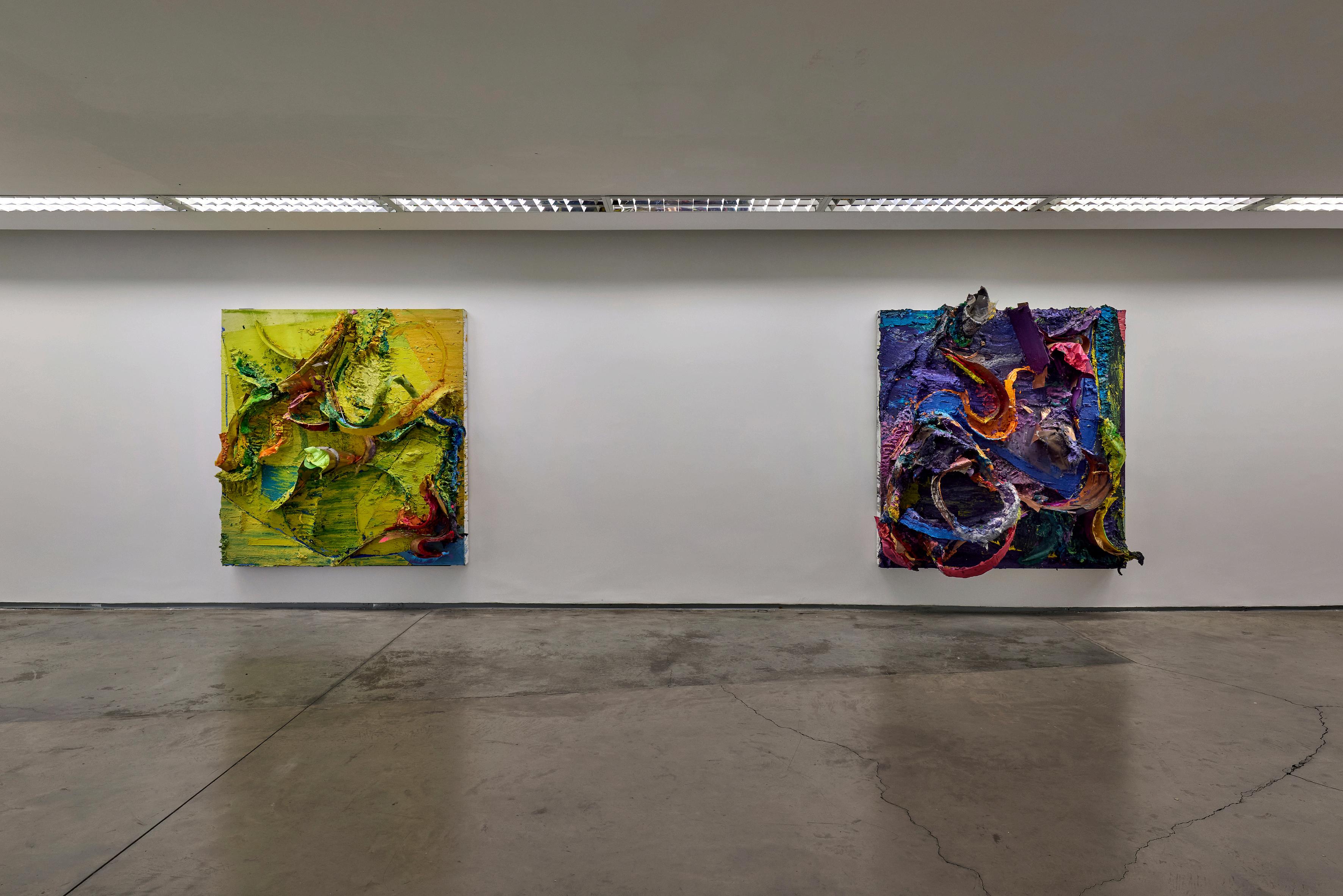


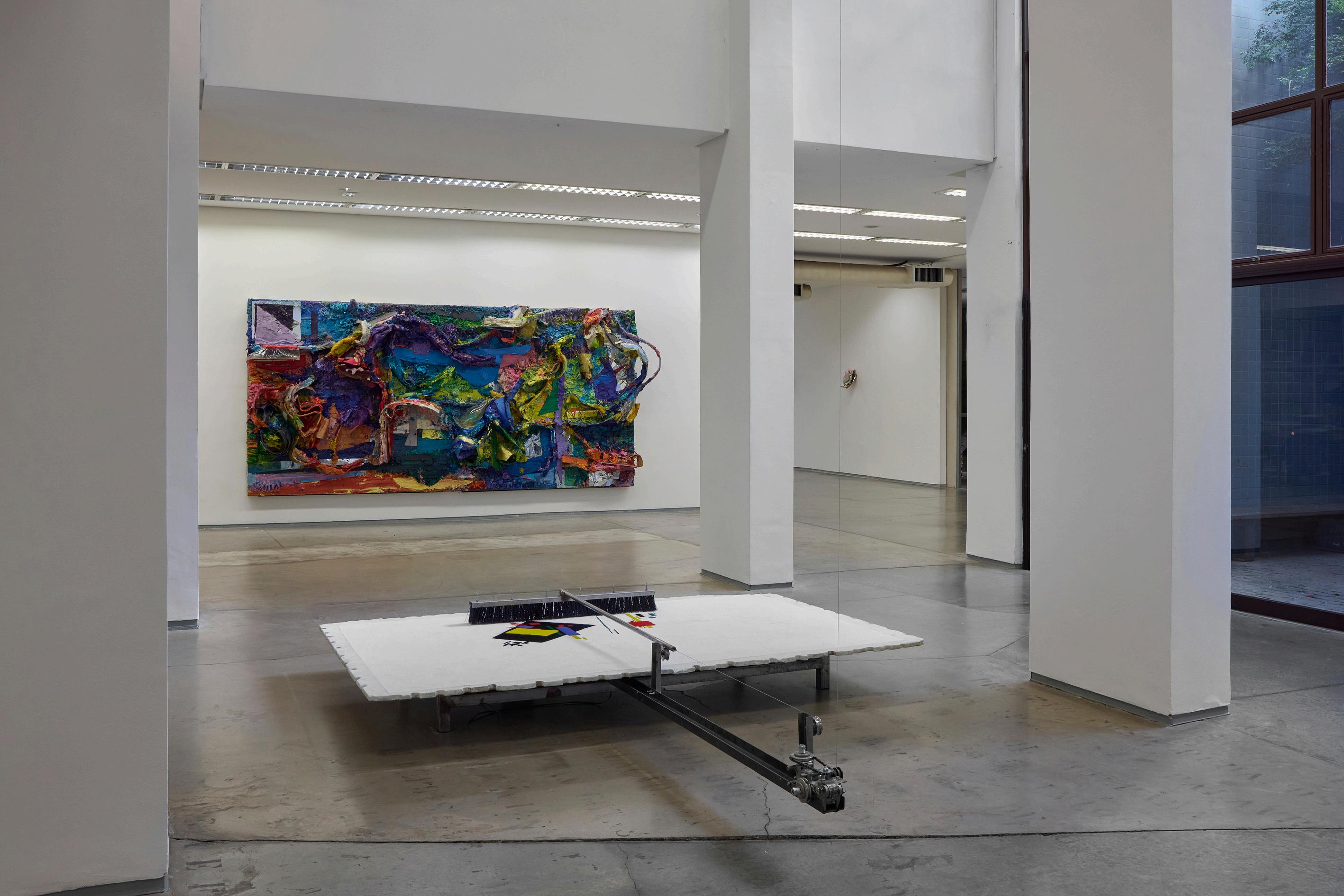






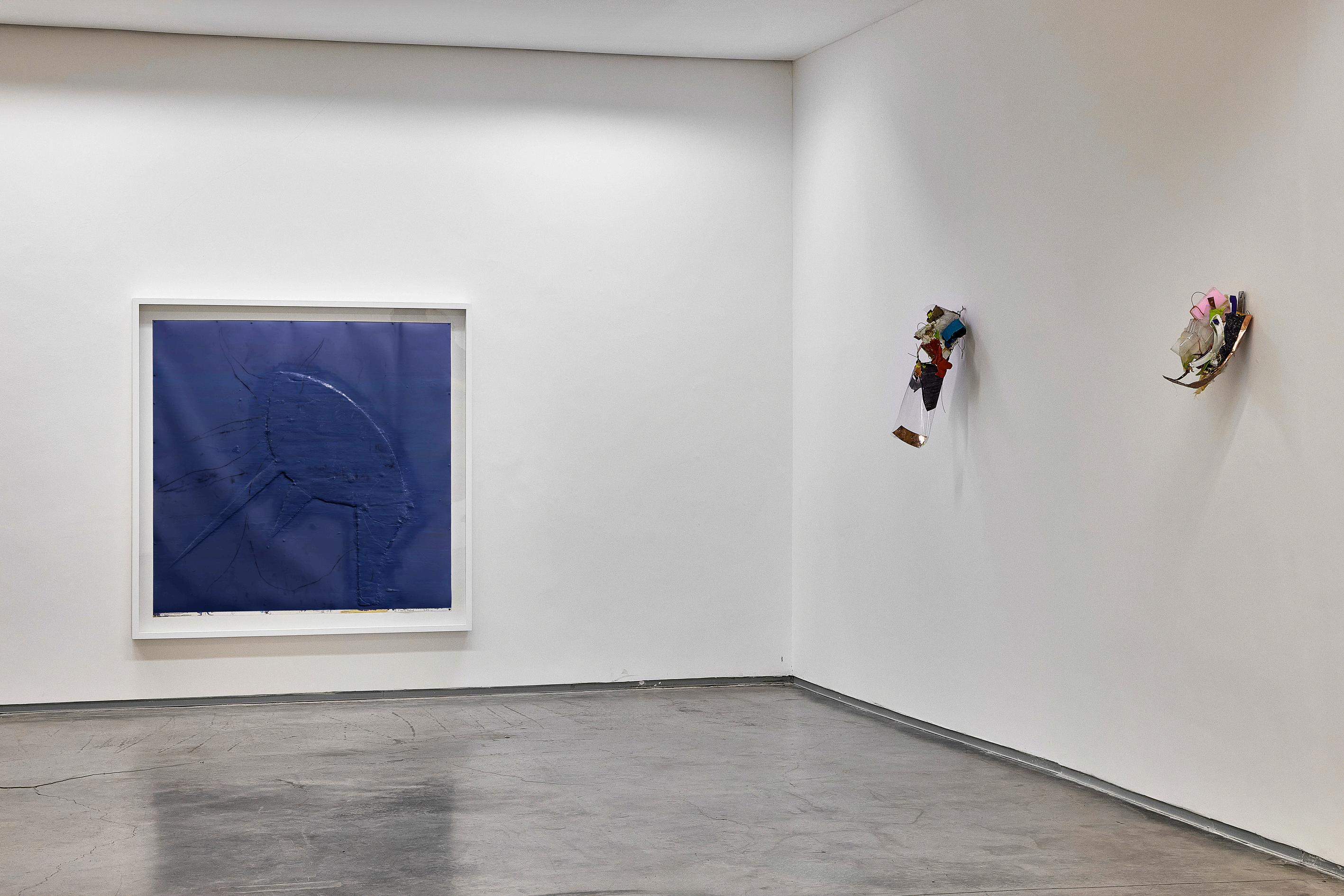




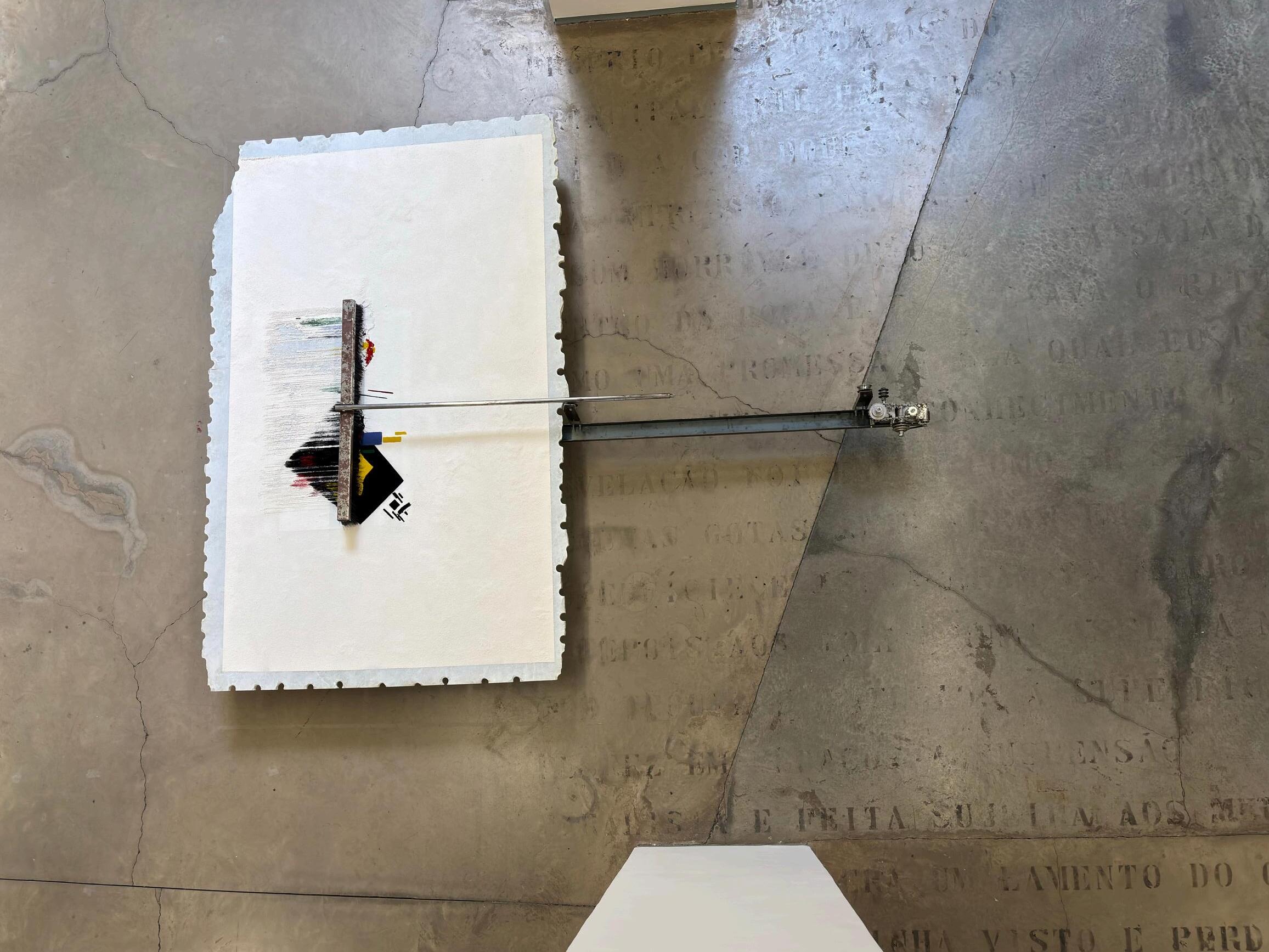




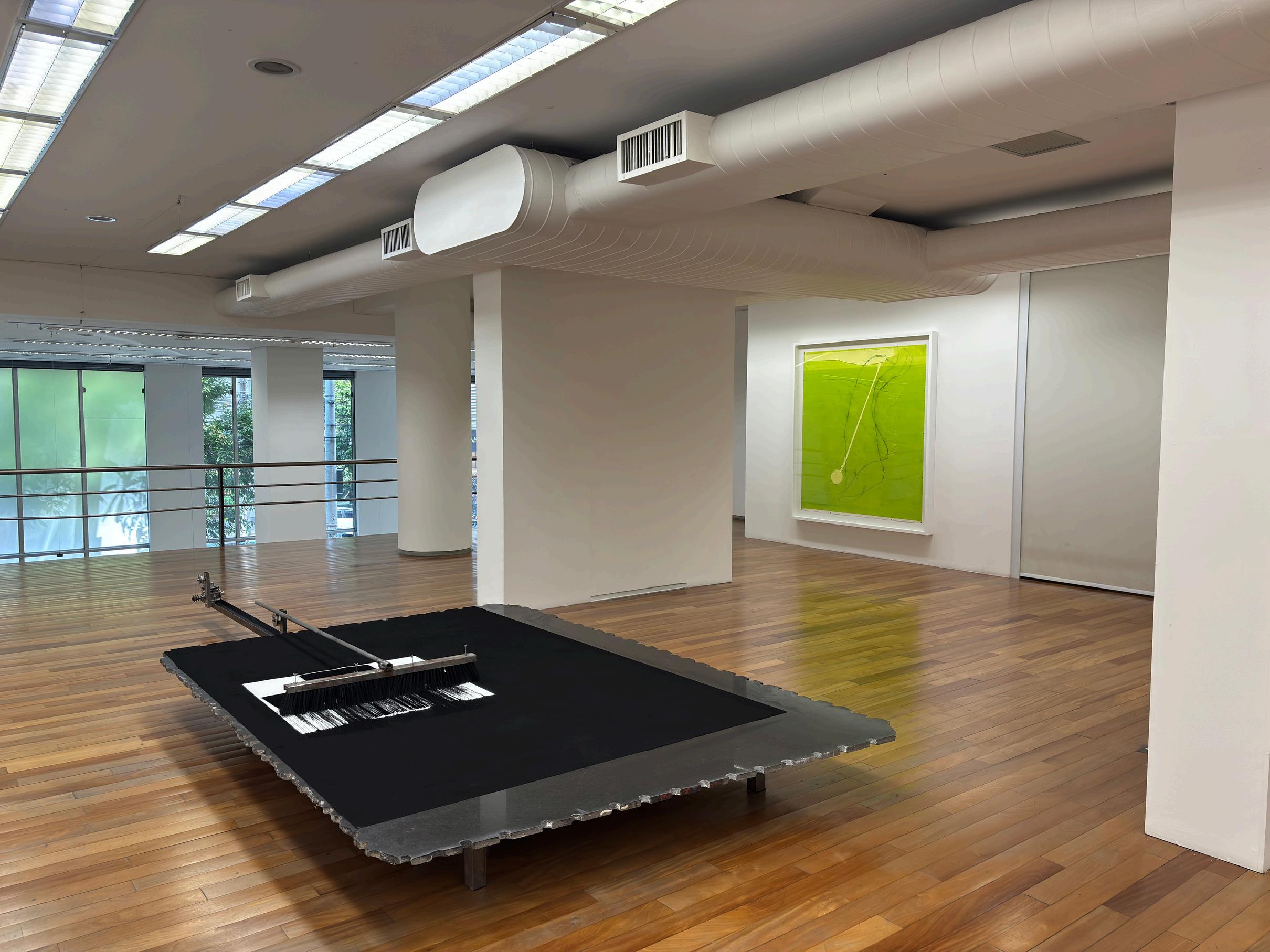


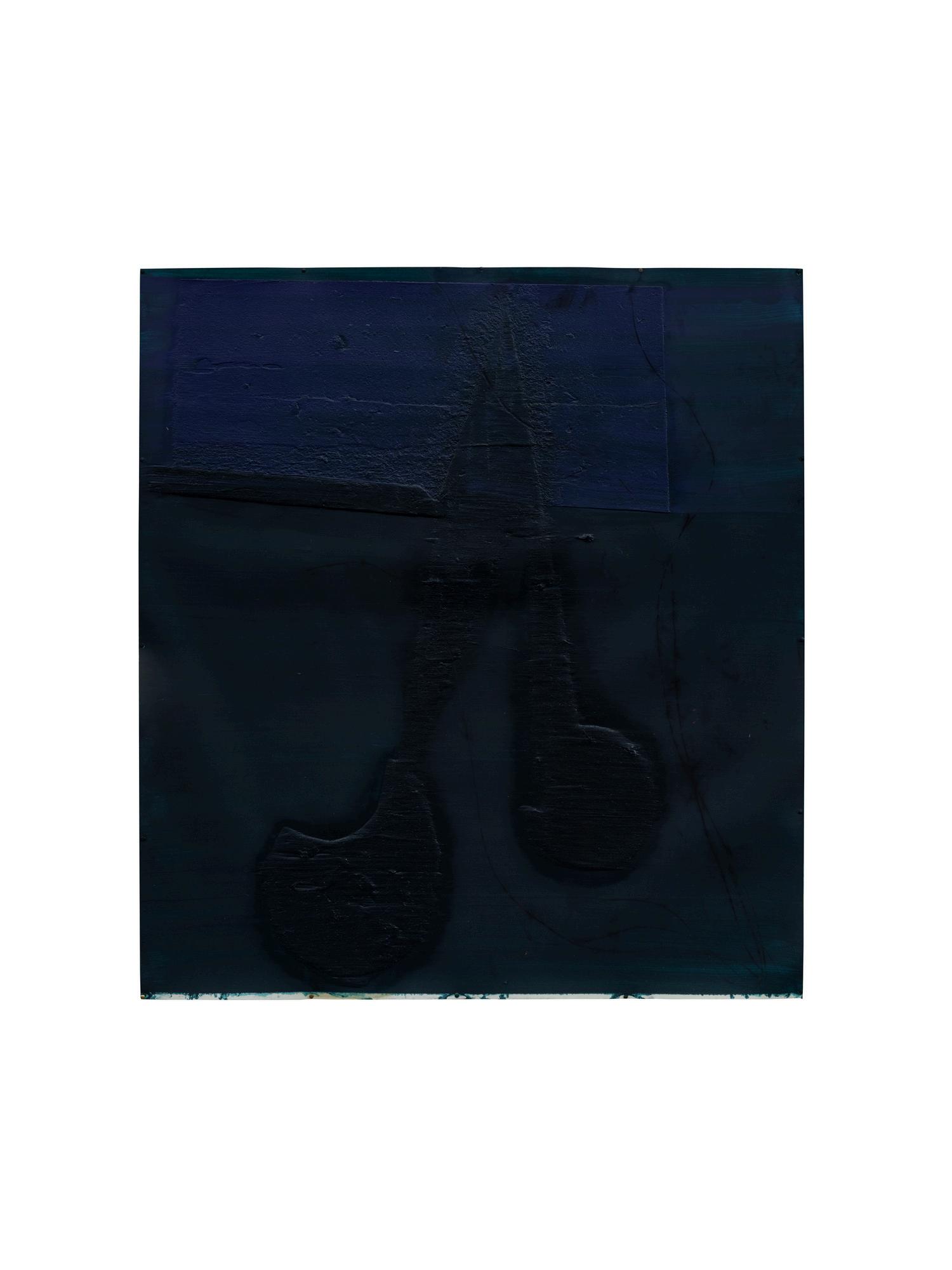
2. Sem título. Untitled. 2024
Tinta a óleo, encáustica, tecidos, plásticos e metais sobre madeira. Oil paint, encaustic, fabrics, plastics and metals on wood.185 x 410 cm
5. Sem título. Untitled. 2024
Tinta a óleo, encáustica, tecidos, plásticos e metais sobre madeira. Oil paint, encaustic, fabrics, plastics and metals on wood.190 x 170 cm
7. 8. Sem título. Untitled. 2024
Tinta a óleo, encáustica, tecidos, plásticos e metais sobre madeira. Oil paint, encaustic, fabrics, plastics and metals on wood.185 x 410 cm
8. 10. Non-objective composition. 2025.
Mármore, cal e pigmento, estrutura metálica e motor. Marble, lime and pigment, metal structure and engine. 420 x 170 x 40 cm
12. Sem título. Untitled. 2025
Tinta a óleo e encáustica sobre papel. Oil paint and encaustic on paper. 189 x 174 x 9 cm cada / each.
16. 17. Sem título. Untitled. 2024
Tinta a óleo, encáustica, tecidos, plásticos e metais sobre madeira. Oil paint, encaustic, fabrics, plastics and metals on wood.185 x 410 cm
18. Sem título. Untitled. 2024
Tinta a óleo, encáustica, tecidos, plásticos e metais sobre madeira. Oil paint, encaustic, fabrics, plastics and metals on wood.190 x 170 cm
19. Ni roi ni foi ni loi, 2024
Tinta a óleo, encáustica, tecidos, plásticos e metais sobre madeira. Oil paint, encaustic, fabrics, plastics and metals on wood.190 x 340 cm
20. O sol não adivinha, 2024
Tinta a óleo, encáustica, tecidos, plásticos e metais sobre madeira.
Oil paint, encaustic, fabrics, plastics and metals on wood.190 x 170 cm
21. 22. La noche oscura, 2024
Tinta a óleo, encáustica, tecidos, plásticos e metais sobre madeira.
Oil paint, encaustic, fabrics, plastics and metals on wood.190 x 170 cm
22. 23. 24. 25. 26. Los Pasos Perdidos, 2024
Tinta a óleo, encáustica, tecidos, plásticos e metais sobre madeira.
Oil paint, encaustic, fabrics, plastics and metals on wood. 210 x 440 cm
23. Trapézio negro e Quadrado vermelho. 2025.
Mármore, cal e pigmento, estrutura metálica e motor. Marble, lime and pigment, metal structure and engine. 265 x 340 x 45 cm
26. 27. 28. Sem título. Untitled. 2024
Tinta a óleo, encáustica, tecidos, plásticos e metais sobre madeira.
Oil paint, encaustic, fabrics, plastics and metals on wood. 190 x 170 cm
28. Sem título. Untitled. 2025
Tinta a óleo, metais e tecidos.
Oil paint, metals and fabrics. 70 x 38 x 36 cm.
29. 30. Sem título. Untitled. 2025
Tinta a óleo e encáustica sobre papel.
Oil paint and encaustic on paper. 172 x 173 x 9 cm.
31. Sem título. Untitled. 2025
Tinta a óleo, metais e tecidos.
Oil paint, metals and fabrics. 70 x 35 x 35 cm. 36 x 25 x 32 cm.

32. 33. Trapézio negro e Quadrado vermelho. 2025.
Mármore, cal e pigmento, estrutura metálica e motor. Marble, lime and pigment, metal structure and engine. 265 x 340 x 45 cm
34. Sem título. Untitled. 2025
Tinta a óleo e encáustica sobre papel.
Oil paint and encaustic on paper. 189 x 174 x 9 cm.
35. Sem título. Untitled. 2025
Tinta a óleo e encáustica sobre papel.
Oil paint and encaustic on paper. 190 x 173 x 9 cm.
36. 37. 38. Cruz negra. 2025.
Mármore, cal e pigmento, estrutura metálica e motor. Marble, lime and pigment, metal structure and engine. 483 x 203 x 45 cm
38. 39. Sem título. Untitled. 2025
Tinta a óleo e encáustica sobre papel.
Oil paint and encaustic on paper. 190 x 173 x 9 cm.
40. Sem título. Untitled. 2025
Tinta a óleo e encáustica sobre papel.
Oil paint and encaustic on paper. 212 x 173 x 9 cm
41. Sem título. Untitled. 2025
Tinta a óleo e encáustica sobre papel.
Oil paint and encaustic on paper. 190 x 173 x 9 cm.
43. Assum. 2024
Tinta a óleo, metais e tecidos.
Oil paint, metals and fabrics. 57 x 53 x 35 cm

Los Pasos Perdidos
Nuno Ramos
15 de Março a 07 de Junho de 2025
March 15th to June 7th, 2025
Albuquerque Contemporânea
Rua Antônio de Albuquerque 885 - Savassi
30112-011, Belo Horizonte - Minas Gerais, Brasil
albuquerquecontemporanea.com
ISBN: 978-65-981908-7-3
Equipe / Team:
Flavia Albuquerque
Lucas Albuquerque
Angelita Bauer
Carlos Donato
Daniela Schneider
Jade Liz
Jackson Cardoso
Julia Zanon
Maria Silva
Marlon Colar
Raphaella Bauer
Sarah James
Texto / Text:
Pollyana Quintella e Victor da Rosa
Tradução / Translation:
Rebecca Atkinson

Fotografias / Photographs:
Jomar Bragança
